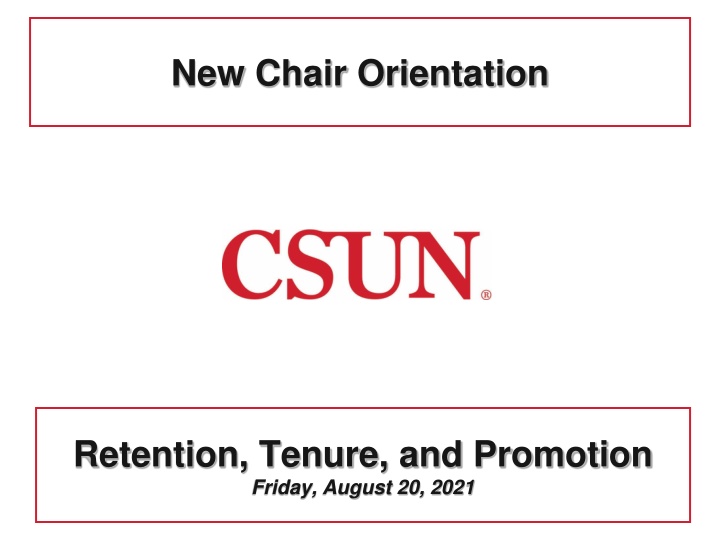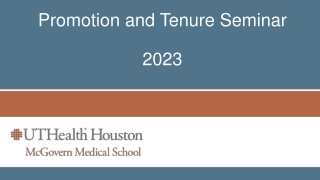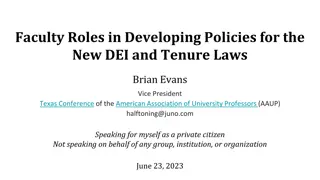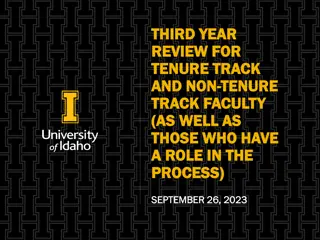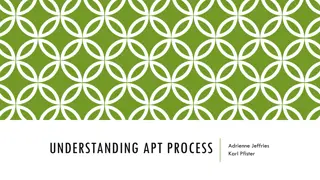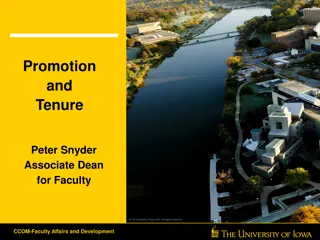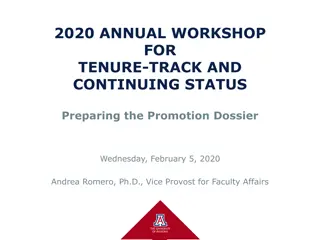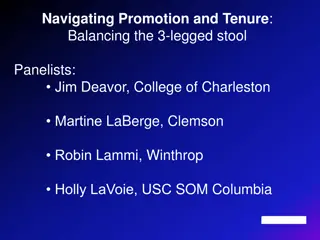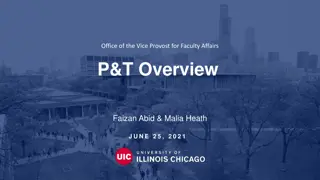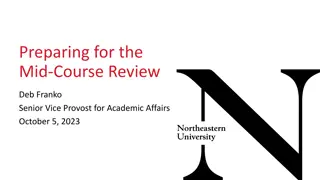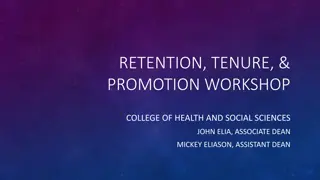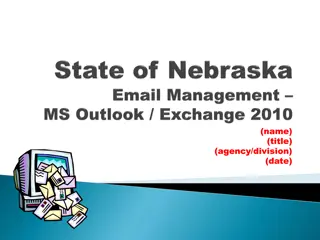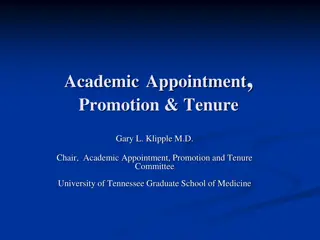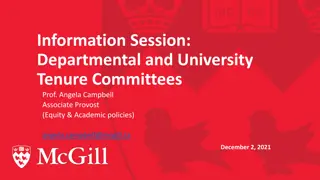New Chair Orientation Retention, Tenure, and Promotion
This document provides an overview of the processes and key personnel involved in retention, promotion, and tenure evaluations for faculty members at CSUN. It outlines the roles of various committees, the review schedule, and essential resources and documents to support the process.
Download Presentation

Please find below an Image/Link to download the presentation.
The content on the website is provided AS IS for your information and personal use only. It may not be sold, licensed, or shared on other websites without obtaining consent from the author.If you encounter any issues during the download, it is possible that the publisher has removed the file from their server.
You are allowed to download the files provided on this website for personal or commercial use, subject to the condition that they are used lawfully. All files are the property of their respective owners.
The content on the website is provided AS IS for your information and personal use only. It may not be sold, licensed, or shared on other websites without obtaining consent from the author.
E N D
Presentation Transcript
New Chair Orientation Retention, Tenure, and Promotion Friday, August 20, 2021
Probationary Faculty Reviewers Department Chair: Performs peer classroom observations and reviews the materials presented by candidates for retention, promotion, and tenure. Department Personnel Committee (DPC): Consists of three, five, or seven tenured faculty at the rank of Associate or Full Professor, elected by the department. The committee performs peer classroom observations and reviews the materials presented by candidates for retention, promotion, and tenure. College Personnel Committee (CPC): Consists of three to seven tenured faculty at the rank of Associate or Full Professor, selected by the College. The committee reviews the materials presented by candidates for retention, promotion, and tenure. Dean of the College: Reviews the materials presented by candidates for retention, promotion, and tenure. Provost:Reviews the materials presented by candidates for retention, promotion, and tenure.
Review Schedule Year of Review* 1st-year 2nd-year Review Retention 3rd-year Review 4th-year Review 5th-year Review Type of Review No Review Highest Level of Review N/A Provost Dean** Provost Dean** Retention Retention Retention Promotion to Associate Professor and Tenure No Review Promotion/ Tenure Become Effective 6th-year Review Provost 7th-year N/A *The award of service credit will speed up the timeline by the number of years awarded. Also, accelerated promotion and early tenure is possible (typically, one year), and requires Provost s review. **If there is a negative recommendation from a review agent, the Provost will conduct the highest-level review.
Key Resources Unit 3 Collective Bargaining Agreement: https://www2.calstate.edu/csu-system/faculty-staff/labor-and-employee-relations/Pages/unit3- cfa.aspx (Articles 10, 13, 14 and 15) Administrative Manual, Section 600: https://www.csun.edu/sites/default/files/SEC600_1819_final%2010.17.18.pdf College and Department Personnel Policies and Procedures: https://www.csun.edu/faculty-affairs/policies Calendar of Personnel Procedures: https://www.csun.edu/faculty-affairs/calendar/index.html FAQ s About Retention, Promotion and Tenure: https://www.csun.edu/sites/default/files/RTP_FAQs.pdf
Key Supporting Documents Professional Information File (PIF, ePIF): https://www.csun.edu/sites/default/files/SEC600_1819_final%2010.17.18.pdf (Section 606.1.1) The PIF is maintained and stored by the Retention, Tenure and Promotion (RTP) candidate. It serves as a portfolio documenting an RTP candidate s professional activities relevant to retention, tenure and promotion at CSUN. Personnel Action File (PAF, ePAF): https://www.csun.edu/sites/default/files/SEC600_1819_final%2010.17.18.pdf (Section 606.1.2) The PAF is maintained by and stored in the office of the Dean of the College. It is the official personnel file for a faculty member that is reviewed for all personnel actions, including retention, tenure, promotion, and service salary adjustments.
Weve Gone Digital! Fully paperless process started Fall 2020 using Interfolio Dean s assistants upload faculty ePAF to Interfolio; faculty upload ePIF; reviewers decisions are recorded in Interfolio
Review and Decision Flow PIF uploaded to Interfolio DPC Evaluates the File DPC invites faculty member to meet with the Committee to discuss PDF and PAF and answer questions Department Chair Evaluates File Chair reviews file and drafts his or her evaluation of the faculty member DPC invites faculty member to meet with the Committee to discuss PDF and PAF and answer questions Chair and DPC consult about evaluations and recommendation of faculty member
Review and Decision Flow DPC and Chair make their separate and independent recommendations Written evaluations emailed to faculty member Faculty Member may respond/rebut within ten (10) days Faculty member receives Evaluations/Recommendations Faculty member receives a copy of the written evaluations from the Chair and DPC Written evaluations will be placed in the PAF after ten (10) days from the date the letter was emailed Faculty member may request a meeting to discuss department-level recommendations Faculty member may submit a rebuttal statement or response in writing to be included in PAF
Department Chair Duties Key in creating supportive department culture Important role in faculty performance, satisfaction, recruitment, and retention One of most difficult roles in the University Straddle the line between: o Colleague and supervisor o Faculty and administrator
Department Chair RTP Dos 1. Mentor faculty on the RTP Process PIF organization PIF contents Important materials Encourage mentoring 2. Follow Department and College Personnel Procedures closely (including Section 600) Base evaluation on policies and procedures Apply accurately to maintain transparency Candidates may elect newer procedures
Department Chair RTP Dos 3. Ensure that: Peer class visit reports are conducted Student evaluations are administered Both are included in the PAF 4. Conduct a review that is: Thorough Fair Unbiased
Department Chair RTP Dos 5. Write accurate and balanced RTP letter: Based on PIF/PAF Verify peer-review of publications Verify claims are true Suggested Resources and Processes Pertaining to Publication Review in RTP Include areas for growth
Department Chair RTP Donts 1. Avoid unbalanced RTP review Carefully read and evaluate scholarly contributions Do not list information incorrectly in RTP letter 2. Avoid disparaging faculty 3. Avoid overly positive RTP review Avoid an anemic RTP review Avoid giving candidate false sense of security
Department Chair RTP Donts 4. Accelerated promotion: Early to Full in second year at rank of associate professor Early to Associate in 2nd, 3rd, or 4th years at rank of assistant professor Early to Associate in year 5 5. Early tenure: Don t forget to make the case Early tenure in Year 5 Case must be made by reviewers for how the early awarding of tenure is advantageous to the University s mission, programmatic needs, or priorities It is the responsibility of the positively recommending agencies to explain why it is advantageous to grant early tenure. 641.2.4.
Department Chair RTP Donts 6. Do not fail to check and verify that: Scholarly contributions genuinely exist and underwent peer-review process Participation on committees (i.e., attendance and active participation)
Sample language Sample sentences of concern: You have generally received positive comments about your teaching from your students and your colleagues Students express concerns . (be specific). Peers note the need to improve (be specific). I note, however, that although these publications demonstrate a pattern of research productivity, they do not meet the criteria for tenure and promotion that is articulated in XXXX Department Personnel Procedures (and/or College Personnel Procedures).
Sample language Sample statement on teaching effectiveness for accelerated promotion: The evidence clearly indicates that you are an effective instructor and that you serve our students well, with both student and peer evaluations attesting to the excellent quality of your instruction. While there is no minimum number of courses required for promotion, I do not believe that it is possible to demonstrate growth appropriate to advancement in rank in only two years. I therefore find that you have not yet met the criteria for teaching effectiveness as set forth in 632.3 of Section 600.
